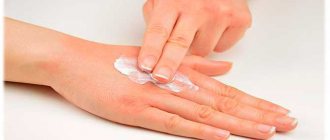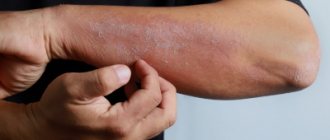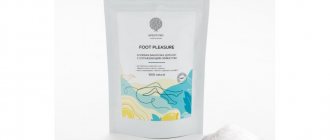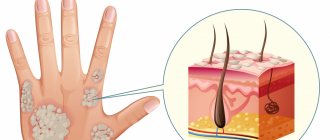Everyone sees the concept of “sensitive skin” differently. Some consider their skin to be sensitive because even after a short exposure to the sun, it instantly burns to redness. The latter do not like the fact that their skin is very sensitive to various cosmetics. And each of them, of course, is right, because such characteristics indicate the tenderness or sensitivity of the skin.
Tenderness, vulnerability, tendency to allergic reactions... Usually dry skin has such innate properties. Whereas normal and fat ones behave more steadfastly. But this characteristic is not constant. Over time, even previously resistant skin can become vulnerable.
Why is this happening?
Human skin is a protective barrier that is affected by many factors. The following factors may influence the appearance of sensitivity:
- Age. Increased sensitivity is noted in people from 18 to 50 years old, then it decreases.
- Impacts of the external environment. The sun, wind, temperature fluctuations and even low ionizing radiation affect the protective properties of the skin.
- Food triggers. What you eat will show up on your face sooner or later. And if you abuse alcohol, coffee or spices, one day this will lead to increased vascular reactivity.
- Stress. Under the influence of stress, the neuroreceptor apparatus of the skin malfunctions.
- Changes in hormonal levels. During certain periods (pregnancy, menopause, etc.), skin sensitivity may become aggravated.
- Dermatitis or rosacea, other skin pathologies.
- Improper skin care is also one of the most common causes of sensitivity.
How to understand whether your skin is sensitive or not?
Sensitive skin reacts sharply to a variety of influences. You can determine the degree of sensitivity by answering the following questions:
- Does your skin often turn red in the cold?
- Do you experience a feeling of heat and “blood rush” to your skin after drinking alcohol or spicy foods?
- Do you experience peeling after going to the pool?
- Do you have any negative skin reactions on your hands to household chemicals?
- Do you feel tightness after washing your face with water?
If you answered yes to most of the questions, most likely your skin is truly hypersensitive.
Main signs of high sensitivity
Sensitive skin is more prone to external factors and is characterized by an excessive reaction to them. Sensitivity is inherent in different skin types: dry, oily, problematic or dehydrated - any skin can be reactive.
It is characterized by:
- redness;
- tingling;
- feeling of tightness;
- itching;
- and even a burning sensation.
Types of skin sensitivity
Of course, in each individual case the skin reacts to irritants in its own way. But specialists from the Scientific Research Center for Healthy Skin in France systematized the symptoms and identified 4 types of sensitivity.
- The first type of sensitivity is caused by stress, food triggers and climatic factors. This is a minor and short-term discomfort.
- The second type manifests itself as a feeling of skin tightness, for example, when being in the cold. Additionally, redness may appear.
- In the third case, to the already listed signs, the appearance of irritation (red spots) is added when using cosmetics, and sometimes even simple cosmetic soap.
- The fourth type is when the appearance of sensitivity depends on the menstrual cycle or is associated with other hormonal changes.
Acquired sensitivity must be combated by eliminating the factor that provoked it. And these factors can be both external and internal.
Sensitive skin
Skin barrier
The regulator of moisture loss through the skin is the stratum corneum of the epidermis. It is what retains the necessary amount of moisture, preventing excessive dryness of the skin. Dry skin entails a decrease in barrier function and is a predisposing factor to skin sensitivity. It is extremely susceptible to adverse external stimuli (trauma, chemicals, infectious agents) and reacts to them with increased sensitivity.
Sebum
Another important protective factor is sebum secreted by the sebaceous glands. The lipid film formed on the surface of the skin softens and protects the skin from damage and infection. Insufficient sebum production also leads to a decrease in the protective barrier and dry skin. At the same time, its excessive secretion increases skin sensitivity, since certain components of sebum (fatty acids, squalene) can cause irritation.
Skin acidity level
The optimal index of acid-base balance of the skin is pH = 5.5. This level of acidity is maintained due to the normal function of the sweat glands. In addition, sweat plays a protective role - it neutralizes mechanical, chemical, and microbial skin contaminants. Violation of the pH index in the acidic direction causes loosening of the epidermis and increased skin sensitivity.
External factors
Some substances commonly used in cosmetic procedures or contained in cosmetics may cause skin sensitivity. These include retinoids - derivatives of vitamin A. Retinoids are used in dermatocosmetology to improve skin condition and treat certain dermatoses. A common side effect of retinoids is dryness, flaking and redness of the skin, and long-term use of them causes particularly sensitive skin. Substances that increase skin sensitivity also include salicylic acid and alpha hydroxy acids (AHAs).
Some ingredients of cosmetics of biological and synthetic origin cause allergization of the skin and the phenomenon of contact dermatitis. This, in turn, also leads to increased skin sensitivity. Among the herbal components, the most common causes of allergic contact dermatitis are extracts of arnica, rosemary, calendula, and sandalwood oil. Among synthetic substances, allergic skin reactions are provoked by preservatives, fragrances, lanolin, emulsifiers, vitamin E, propylene glycol, etc.
Proper care for sensitive skin
For complete care, it is important to take several steps:
- To cleanse, use products that maintain the physiological balance of the epidermis.
- Choose products labeled “for sensitive skin.”
- Use the soothing toner as the first step in the morning to refresh your skin and as a makeup remover.
- Pay attention to thermal water with a high content of Selenium.
- Use hypoallergenic cosmetics.
Now you know how to care for sensitive skin. We offer you to choose the best care products.
Causes of numbness in hands, feet, fingers
Numbness of both hands or individual areas on the right and left hand (fingers, hands) can be caused by:
- cerebrovascular accident,
- multiple sclerosis,
- a tumor in the structures of the brain,
- pernicious anemia.
Symmetrical numbness in any area of the right and left arms in combination with some motor disorders of the limb may be a sign of polyneuropathy - a disease affecting the peripheral nerves, which mainly develops in people suffering from chronic alcoholism, diabetes mellitus, and severe intoxication. This type of numbness usually develops gradually.
Numbness of the fingers, accompanied by pain, paleness and coldness of the fingers, is a consequence of spasm of the blood vessels in the fingers and is characteristic of Raynaud's disease, scleroderma and some other diseases.
If numbness of the arm or any part of it develops against the background of existing headaches, pain in the back, neck or chest, then the cause of this phenomenon may be some disease of the spine, for example, osteochondrosis, protrusion, intervertebral hernia or spondylosis.
Numbness in the little finger and/or ring finger when their function is impaired may be a symptom of ulnar nerve neuropathy. This disease mainly occurs in people who are forced to lean on their elbow for a long time, which leads to nerve damage.
A feeling of numbness in the fingers, with the exception of the little finger, which is accompanied by pain that worsens at night, may be a sign of carpal tunnel syndrome, the development of which is facilitated by injuries, arthritis, swelling due to hypothyroidism, and pregnancy.
Numbness and pain in the legs after prolonged walking or standing may appear due to vascular diseases: chronic venous insufficiency, atherosclerosis of the lower extremity vessels, obliterating endarteritis.
If numbness is localized on the back of the leg, and there are characteristic “shooting” pains in the lower back and/or leg, then the likely cause of these symptoms is pinched sciatic nerve, or sciatica. Typically, this syndrome occurs due to osteochondrosis of the lumbar spine, intervertebral hernia, spinal stenosis, spondylolisthesis, and back injury.
Numbness on the left and right sides of the body: what are the differences?
Numbness of the right arm or leg, simultaneous or sequential, occurs with osteochondrosis, scoliosis, herniated intervertebral discs, when the blood supply to tissues and the conductivity of nerve endings are disrupted. If this syndrome was preceded by a sensitive acute headache or injury, the cause may be much more serious - a stroke or a brain tumor.
When a sensitivity disorder is observed on the left side of the body, a person feels a tingling sensation, and the motor functions of the limbs suffer. If at the same time the facial muscles go numb, blood pressure rises, and dizziness appears, this suggests an ischemic or hemorrhagic stroke or serious pathologies of cerebral circulation. Therefore, numbness on the left is considered a more dangerous symptom than on the right.
Opportunities for professional cosmetology care
Sensitive skin problems can be effectively solved with modern hardware and injection cosmetology techniques.
People with hyperreactive skin in the acute phase are often prescribed microcurrent therapy. Sessions of this procedure normalize the condition of the skin, eliminate signs of inflammation, have a strengthening effect on blood vessels, and improve the general condition and appearance of the skin. As an auxiliary treatment, a doctor may prescribe a course of ozone therapy. It provides an anti-inflammatory effect and has an immunostimulating effect.
During the period of weakening of the manifestations of hypersensitivity, gentle superficial peels are appropriate: almond, glycolic, retinoic. The effectiveness and safety of the procedure in this case depends on the professionalism of the cosmetologist, who must conduct a preliminary test for sensitivity and be well aware of the individual characteristics of the patient.
Biorevitalization has proven itself to be effective in solving such problems. Native hyaluronic acid, the main active component of the administered drug, has a complex antioxidant and anti-inflammatory effect, strengthens blood vessels, stimulates microcirculation processes, increases skin tone and improves its appearance.
Types of Numbness
Depending on the disease that provoked the syndrome, numbness can affect different parts of the body:
- If the cause is a pathology of the brain, the loss of sensitivity will affect the limbs on the opposite side. So, if the right hemisphere is damaged, the left leg or arm will suffer.
- With diseases of the spinal cord, numbness occurs in the area located below.
- Polyneuropathy provokes the “gloves and socks” syndrome.
- If the culprit is a peripheral nerve, the person will feel a loss of sensitivity in a finger - for example, the little toe on the foot, or the big toe - in the area of innervation.
Causes of skin hypersensitivity
Increased sensitivity of the skin of the face and body can be explained by several factors - both individual and their combination. Why can skin become sensitive?
- The reasons may be the characteristics of the blood vessels. Fragile vessel walls can be damaged under the influence of external factors, for example, spicy food or alcohol consumption.
- Wind, dryness, cold, sun or poor environment can cause tingling or burning.
- Some substances that are poorly tolerated by the skin can also cause a reaction. For example, your skin may react to hard water.
results
Patients with acne-type skin sensitivity (n=5) used the Topicrem Calm+ line for increased skin sensitivity that developed during external or systemic anti-acne therapy. On the 5-7th day of therapy, all patients showed a decrease in the intensity of symptoms, and on the 10-14th day - their complete regression.
Clinical case 1. An 18-year-old female patient complained of a burning sensation, a feeling of skin tightness and redness of the facial skin. Since the age of 16, the patient has been bothered by acne on her face. Burning and redness of the facial skin appeared on the 5th day of using the drug for external treatment of acne (adapalene gel).
Status localis. On the skin of the face (forehead, cheeks, chin) there are multiple closed comedones, inflammatory papules, single pustules, as well as pink erythema, the location of which coincides with the areas where the therapeutic gel is applied. In the erythema area there is slight peeling of the skin. Diagnosis: acne vulgaris (L.71), simple irritant dermatitis caused by drugs (L.24.4). It is recommended to temporarily cancel external treatment. Medical and cosmetic care was prescribed in the form of monotherapy with Topicrem Calm+ (micellar water, light cream). A significant reduction in symptoms was noted on days 5-7 of treatment (Fig. 2) .
Rice. 2. Acne type (S1) skin sensitivity.
a - before treatment; b — after 7 days of treatment with Topicrem Calm+.
Ten patients with rosacea-type skin sensitivity (mainly with the erythematous-telangiectatic stage), using Topicrem Calm+ products, noted a rapid regression of subjective sensations (on the 2nd day) and a significant decrease in the intensity of skin manifestations by the 7-10th day of therapy.
Clinical case 2. A 45-year-old patient complained of episodes of transient redness of the skin under the influence of emotional and nutritional factors, burning of the skin upon contact with water, and rashes on the skin of the cheeks. Considers himself sick for 1 year. It was not treated independently, the rash periodically regressed spontaneously. Recently, the skin process has become persistent.
Status localis. On the skin of the cheeks there is diffuse erythema of a pale pink color, against which isolated bright pink papules with a diameter of up to 0.3 mm, single finely looped telangiectasias and slight peeling in the cheek area are observed. Diagnosis: rosacea (L.71). Based on your skin type (combination type with increased oiliness in the T-zone), micellar water and Topicrem Calm+ light cream are prescribed. The patient noted the disappearance of subjective sensations in the first days of using the cream. A significant regression of skin rashes was observed on the 7th day of treatment (Fig. 3) . The patient continued to use cosmetics after the end of the observation period.
Rice. 3. Rosacea type (S2) skin sensitivity.
a - before treatment; b — after 7 days of treatment with Topicrem Calm +.
There were 6 patients with S3 type of skin sensitivity under our supervision. Selecting care products for patients with this type of sensitivity is a difficult task. The correct selection of moisturizer texture based on skin type is of fundamental importance. Sometimes the wrong choice of care product causes negative effects.
Clinical case 3. A 35-year-old female patient complains of burning and redness of the skin of the nasolabial folds when applying cosmetic cream, and a feeling of skin tightness after washing. I asked for a selection of facial skin care products. Status localis. There are no rashes on the face, the skin is pale and dull. In the T-zone, enlarged pores, increased greasiness, and oily shine are observed. There is fine peeling on the entire surface of the facial skin. Taking into account the combination skin type, dehydration and hypersensitivity of the skin, therapeutic and cosmetic care using Topicrem Calm+ cosmetics (micellar water and light cream) was prescribed. On the 2nd day of treatment, the patient noted the appearance of rashes on the skin of the forehead (Fig. 4) , increased greasiness in the area of the nasolabial folds and chin. It is recommended to change the form of the cream to a fluid, with the use of which a rapid regression of rashes and the disappearance of subjective complaints were noted. The patient continued cosmetic care using Topicrem Calm+ fluid.
Rice. 4. S3 type of skin sensitivity. Exacerbation after using light cream Topicrem Calm + .
The majority of observed patients (n=19) had type 4 skin sensitivity (S4), prone to contact dermatitis. In all patients, the use of Topicrem Calm+ products was found to be highly effective. Subjective sensations (feeling of tightness, burning) regressed on the 2-3rd day of therapy, clinical manifestations - on the 7-10th day of treatment. By the end of the observation, the appearance of the skin also improved: dullness, even color and freshness of the skin appeared, peeling regressed.
Clinical case 4. A 45-year-old female patient complains of a feeling of tightness and tingling of the skin when exposed to adverse weather conditions and contact with water. The duration of the disease is more than 5 years. Rashes began to appear on my face periodically.
Status localis. The skin of the face is matte, the pores are narrowed. On the skin of the cheeks and temporal areas there are multiple erythematous spots with a diameter of 0.5 to 1 cm, with blurred boundaries. There is slight peeling on the surface of the spots. Diagnosis: simple irritant dermatitis (L.24), weather-dependent (Fig. 5) . Taking into account the dry skin type, the patient was prescribed therapeutic and cosmetic care with Topicrem Calm+ using micellar water and rich cream. A rapid regression of subjective sensations was noted after 1 day. By the 7th day, the symptoms of dermatitis and peeling regressed, and the appearance of the facial skin improved. The patient continued cosmetic care.
Rice. 5. S4 skin sensitivity type.
a - before treatment; b — after 7 days of treatment with Topicrem Calm+.
During the survey, the majority of patients highly rated the products of the Topicrem Calm+ cosmetic line (39 patients when evaluating micellar water and 33 patients when evaluating moisturizer). Only 2 patients gave an unsatisfactory assessment when using a moisturizer (the appearance of “irritation” of the skin, increased oiliness), which is due to the incorrect choice of its texture (Fig. 6) .
Rice. 6. Subjective assessment by patients of the tolerability of cosmetics. Excellent (3 points), good (2 points), unsatisfactory (1 point).











